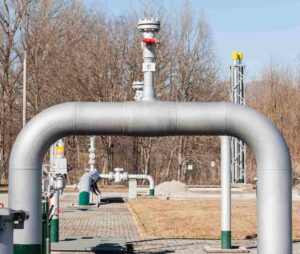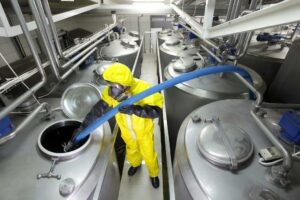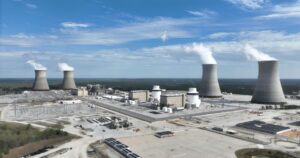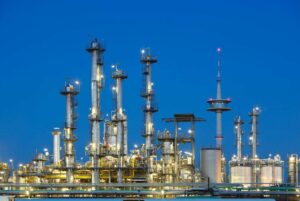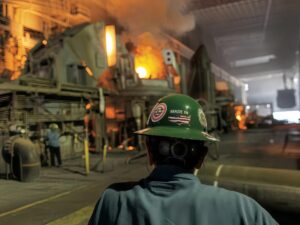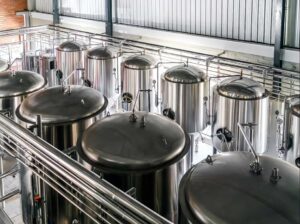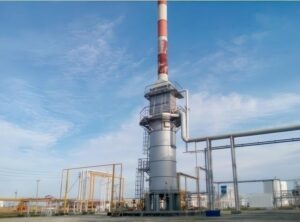When every breath counts, undetected gas imbalances can be fatal. In medical environments, the pressure to maintain precise gas monitoring is relentless—but gas analyzers deliver the control and confidence clinicians need. Medical gas analyzer plays a crucial role in medical applications by ensuring accurate monitoring of respiratory gases, maintaining patient safety during surgeries, and supporting various diagnostic processes.
Beyond simply identifying gas composition, medical gas analyzers help detect life-threatening anomalies and guide clinical decisions. Their reliability and precision make them indispensable across every stage of patient care.
Why is a Medical Gas Analyzer Essential in Hospital Operating Rooms?
An undetected shift in anesthesia gas levels can turn a routine surgery into a life-threatening emergency. Operating rooms depend on precise gas control to maintain patient safety and procedural success.
In surgical settings, gas analyzers are critical for continuously measuring the concentration of oxygen (O₂), nitrous oxide (N₂O), carbon dioxide (CO₂), and volatile anesthetic agents. This real-time analysis ensures accurate delivery of anesthetic gases, alerts clinicians to leaks or deviations, and supports immediate corrective action.
Without a reliable gas analyzer, clinicians would lack essential feedback about a patient’s ventilatory status and anesthetic depth. Integration with anesthesia workstations allows these devices to track expired and inspired gas ratios, enabling adjustments during the procedure. Moreover, many systems include alarms for abnormal gas levels, preventing complications such as hypoxia, hypercapnia, or anesthetic overdose. In complex surgeries or when managing high-risk patients, this continuous data stream can make the difference between complication and control.
How is the Medical Gas Analyzer Used in Respiratory Monitoring?
Respiratory decline often starts subtly—but delays in detection can lead to critical deterioration. Accurate, real-time monitoring of respiratory gases is vital in managing patients with compromised lung function.
Gas analyzers enable non-invasive, continuous tracking of key respiratory gases, particularly carbon dioxide (CO₂) and oxygen (O₂), across various care settings. They provide clinicians with essential data on ventilation efficiency, metabolic activity, and airway integrity, supporting faster and more informed clinical decisions.
In pulmonary wards, emergency rooms, and sleep labs, gas analyzers assess end-tidal CO₂ (EtCO₂), fractional inspired O₂ (FiO₂), and oxygen saturation trends. These parameters help diagnose conditions such as COPD, sleep apnea, or hypoventilation. By integrating with capnography or spirometry systems, gas analyzers also detect issues like airway obstruction or ineffective ventilation in real-time. This allows immediate adjustment of oxygen flow or ventilator settings—especially important during procedures like intubation or when managing non-invasive ventilation.
Moreover, portable gas analyzers make it possible to perform spot checks during transport or at the bedside, ensuring continuity of care even outside traditional respiratory monitoring environments.
What Role Does a Medical Gas Analyzer Play in Emergency and Intensive Care?
In critical care, every second counts—misjudging a patient’s respiratory status can cost their life. Accurate gas monitoring is not optional in ICUs and emergency settings; it’s a frontline tool for survival.
Gas analyzers in emergency and intensive care environments provide real-time analysis of respiratory gases such as oxygen (O₂), carbon dioxide (CO₂), and nitric oxide (NO), enabling immediate intervention when patients face acute respiratory distress, trauma, or multi-organ failure.
In ICUs, gas analyzers are integrated into ventilators and monitoring systems to assess end-tidal CO₂ and arterial blood gas levels. This data supports decisions on ventilator adjustments, sedation depth, or oxygen therapy. Alarms for deviations in gas concentrations ensure that sudden deteriorations—such as hypoxia or hypercapnia—are not missed.
In emergency departments or during patient transport, portable gas analyzers help clinicians quickly assess a patient’s respiratory function without waiting for lab results. For example, analyzing EtCO₂ in a non-intubated trauma patient can reveal hidden airway compromise, while monitoring oxygen levels during CPR ensures effective ventilation. These devices also assist in managing sepsis, neurological emergencies, and drug overdoses, where respiratory function often destabilizes rapidly.
Ultimately, gas analyzers serve as a constant, silent guardian in high-stakes environments—delivering data that saves lives in moments when time is everything.
How is the Medical Gas Analyzer Applied in Pulmonary Function Testing?
Breathing may seem simple, but diagnosing lung disorders requires high-precision gas measurement. Pulmonary function testing (PFT) depends on gas analyzers to assess how well the lungs transfer and process gases.
Gas analyzers are integral to pulmonary function testing, where they measure the concentrations of gases like oxygen (O₂), carbon dioxide (CO₂), helium (He), and nitrogen (N₂) to evaluate lung volumes, diffusion capacity, and airway resistance. These measurements are essential for diagnosing obstructive and restrictive pulmonary diseases.
During tests such as spirometry, body plethysmography, and the diffusion capacity of carbon monoxide (DLCO) test, gas analyzers monitor how inhaled gases behave within the respiratory system. For example, in DLCO testing, the patient inhales a trace gas mixture—typically including carbon monoxide and helium—and the analyzer determines how effectively the lungs transfer gas from the alveoli into the bloodstream.
By precisely tracking changes in gas concentration before and after each breath, clinicians can detect early signs of conditions like pulmonary fibrosis, emphysema, and asthma. Moreover, gas analyzers ensure that test results are not just accurate, but reproducible across patients and time intervals—crucial for long-term disease monitoring or treatment evaluation.
Their sensitivity and responsiveness make gas analyzers indispensable tools in both diagnostic and occupational respiratory assessments.
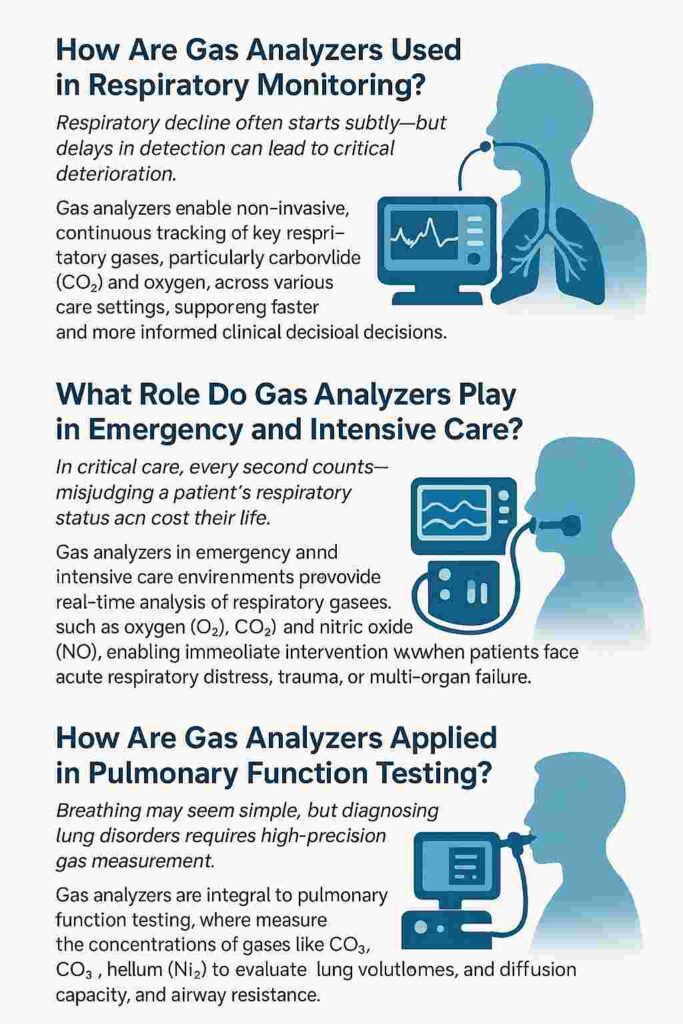
Conclusion
| Application Area | Core Function | Gases Monitored | Typical Devices or Technologies | Clinical Significance |
| Respiratory Monitoring | Real-time tracking of respiratory gases to detect early respiratory failure | O₂, CO₂ | Nasal cannula + Capnography / EtCO₂ analyzers | Early detection of respiratory decline; optimized oxygen and ventilation support |
| Emergency & Intensive Care | Rapid assessment of respiratory status to guide critical interventions | O₂, CO₂, NO | Bedside analyzers, portable gas analyzers, ventilator-integrated systems | Fast decision-making; prevents respiratory failure in acute or multi-organ conditions |
| Pulmonary Function Testing | Measuring lung volumes and gas exchange to assess pulmonary efficiency | CO, He, N₂ (indirectly evaluates O₂ and CO₂) | DLCO systems, helium dilution analyzers, spirometry devices | Diagnosing asthma, emphysema, fibrosis; tracking long-term treatment response |







